Review: the matrix multiplication operation
+- -+ +- -+
|A11 A12 A13| |B11 B12 B13|
A = |A21 A22 A23| B = |B21 B22 B23|
|A31 A32 A33| |B31 B32 B33|
+- -+ +- -+
Then:
+- -+
|C11 C12 C13|
C = A*B = |C21 C22 C23|
|C31 C32 C33|
+- -+
where:
Cij = ∑k=0..N-1 AikBkj
(for i = 0, 1, .., N-1 and j = 0, 1, ..., N-1)
|
The matrix multiplication with two (2) N×N matrices (C = A × B):
int N = ...; // Some pre-defined value
float A[N][N]; // Matrix 1
float B[N][N]; // Matrix 2
float C[N][N]; // Output matrix
//CPU matrix mult alg for static 2-dimensional arrays
for (int i = 0; i < N; i++)
for (int j = 0; j < N; j++)
{
/* ---------------------------------
Compute the matrix element
Cij = ∑k=0..N-1 AikBkj
--------------------------------- */
C[i][j] = 0.0;
for (int k = 0; k < N; k++)
C[i][j] = C[i][j] + A[i][k]*B[k][j]; // "inner" vector product
}
|
Limitations on using 2-dimensional arrays in C:
|
Better solution:
|
Problem: we
cannot
use expression
A[i][j]
(2 dim index) to
access the
allocated elements
We must use
A[i]
(1 dim index) !!!
The memory space allocated by the malloc( ) function:
|
The memory space
allocated by
malloc( ) has
a one-dimensional structure !!
(The memory cells are
consecutive in
memory, so they are
line up on
a "straight line")
Mapping a 2-dimensional matrix to a 1-dimensional array (allocated by malloc( )):
|
We will discuss the mapping function next
Mapping a 2-dimensional matrix to a 1-dimensional array (allocated by malloc( )):
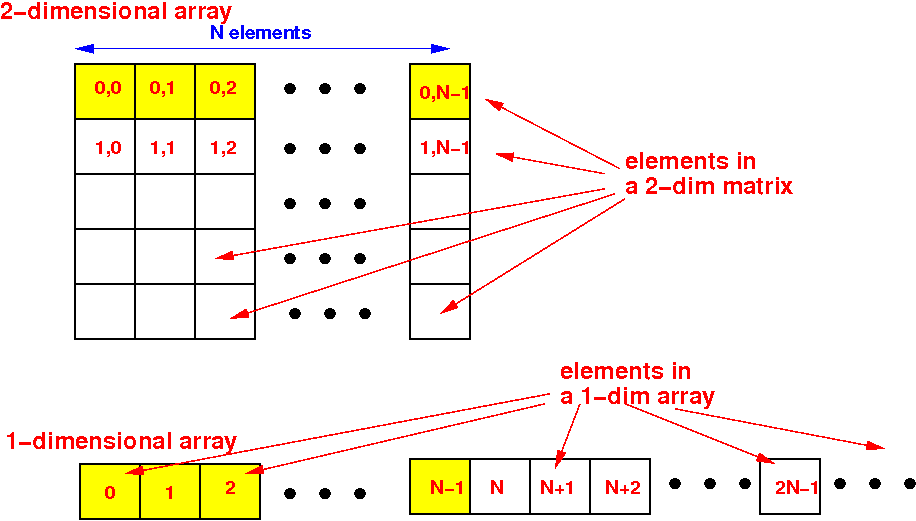
We will map the matrix elements row-wise onto the 1-dim array next
We map the 1st row of the matrix to the first N elements in 1-dim array:
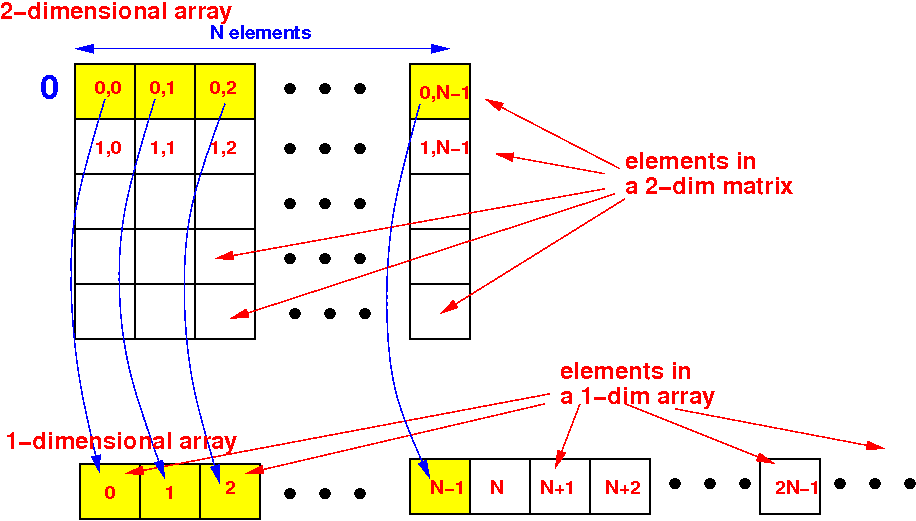
Relationship: w (1-dim index) = 0×N + j
We map the 2nd row of the matrix to the second N elements in 1-dim array:
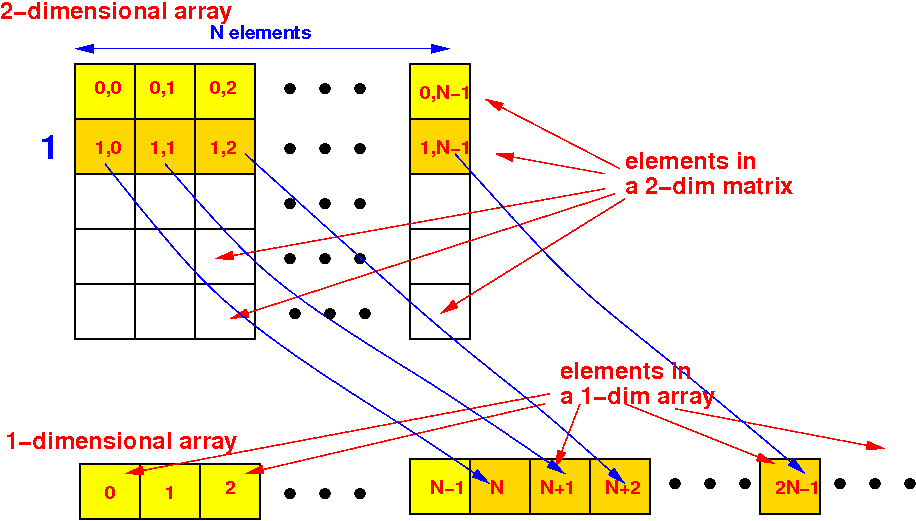
Relationship: w (1-dim index) = 1×N + j
We map the 3rd row of the matrix to the third N elements in 1-dim array:
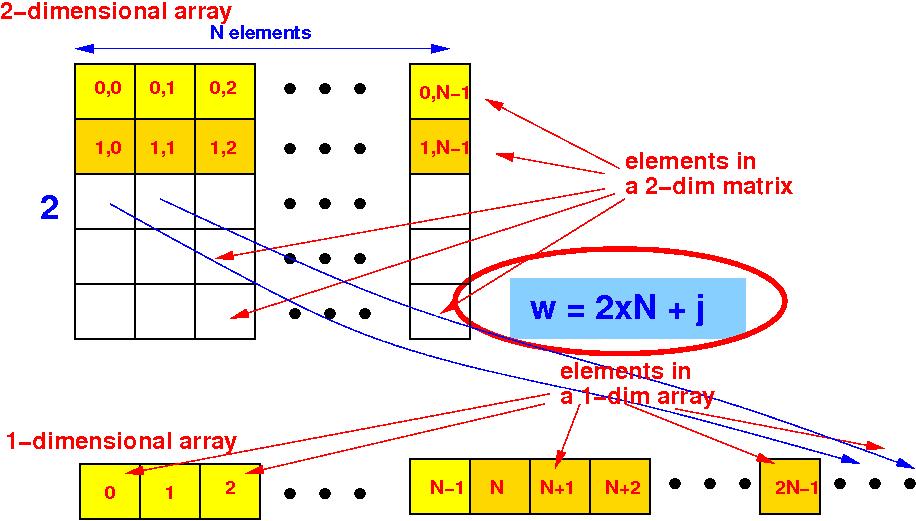
Relationship: w (1-dim index) = 2×N + j --- and so on..
The mapping function from a 2-dimensional index (i,j) to a 1-dimensional index w is:

How to linearize a 2 dim index (i,j) to a 1-dim index w: w (1-dim index) = i×N + j
The reverse mapping function from a 1-dimensional index w to a 2-dimensional index (i,j):
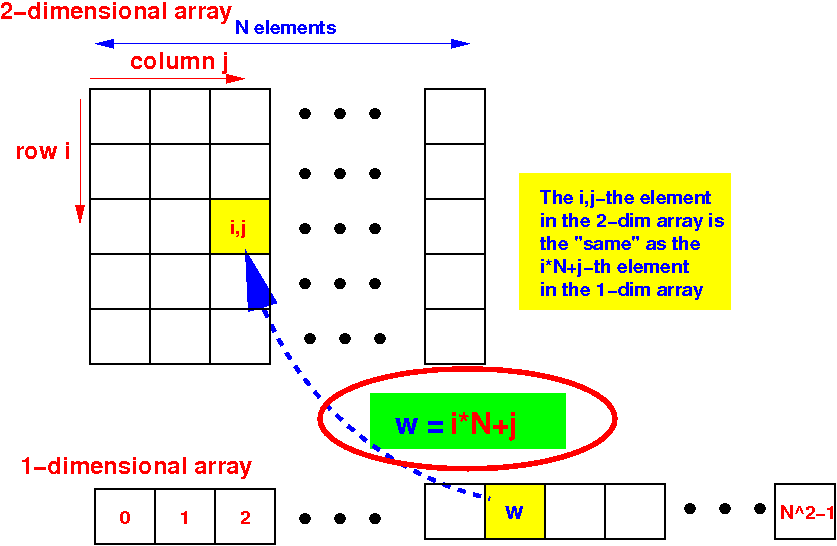
w (1-dim index) = i×N + j --- Question: what is i = f(w) and j = g(w) ??
The reverse mapping function from a 1-dimensional index w to a 2-dimensional index (i,j) is:

Relationship: i = w/N and j = w%N
Recall: The matrix multiplication with 2 dimensional arrays
int N = ...; // Some pre-defined value
float A[N][N]; // Matrix 1
float B[N][N]; // Matrix 2
float C[N][N]; // Output matrix
//CPU matrix mult alg for static 2-dimensional arrays
for (int i = 0; i < N; i++)
for (int j = 0; j < N; j++)
{
/* ---------------------------------
Compute the matrix element
Cij = ∑k=0..N-1 AikBkj
--------------------------------- */
C[i][j] = 0.0;
for (int k = 0; k < N; k++)
C[i][j] = C[i][j] + A[i][k]*B[k][j]; // 1 vector product
}
|
We change it to use allocated arrays:
int N = ...; // Some pre-defined value float *A = malloc(N*N*sizeof(float)); // Matrix 1 float *B = malloc(N*N*sizeof(float)); // Matrix 2 float *C = malloc(N*N*sizeof(float)); // Output matrix //CPU matrix mult alg for static 2-dimensional arrays for (int i = 0; i < N; i++) for (int j = 0; j < N; j++) { /* --------------------------------- Compute the matrix element Cij = ∑k=0..N-1 AikBkj --------------------------------- */ C[i][j] = 0.0; for (int k = 0; k < N; k++) C[i][j] = C[i][j] + A[i][k]*B[k][j]; // 1 vector product } |
We map the 2-dim array index [i][j] to a 1-dim index [i*N+j]:
int N = ...; // Some pre-defined value float *A = malloc(N*N*sizeof(float)); // Matrix 1 float *B = malloc(N*N*sizeof(float)); // Matrix 2 float *C = malloc(N*N*sizeof(float)); // Output matrix //CPU matrix mult alg for static 2-dimensional arrays for (int i = 0; i < N; i++) for (int j = 0; j < N; j++) { /* --------------------------------- Compute the matrix element Cij = ∑k=0..N-1 AikBkj --------------------------------- */ C[0*N+0] = 0.0; for (int k = 0; k < N; k++) C[i*N+j] = C[i*N+j] + A[i*N+k]*B[k*N+j]; //1 vec product } |
DEMO: /home/cs355001/demo/CUDA/4-mult-matrix/cpu-mult-matrix.c
Recall that we can create B blocks with T (T ≤ 1024) threads/block:
#include <stdio.h>
#include <unistd.h>
__global__ void hello( )
{
printf("gridDim.x=%d, blockIdx.x=#%d,
blockDim.x=%d, threadIdx.x=#%d -> ID=%d\n",
gridDim.x, blockIdx.x, blockDim.x, threadIdx.x,
blockIdx.x*blockDim.x+threadIdx.x);
}
int main()
{
hello<<< B, T >>>( );
printf("I am the CPU: Hello World ! \n");
cudaDeviceSynchronize();
}
|
Each thread can
compute its
unique ID using
blockIdx.x*blockDim.x+threadIdx.x.
Thread k will
compute
C[i][j]
where i =
k/N and
j =
k%N
The CPU code: (1) allocate arrays and (2) then launches the threads (as <<< B,T >>>):
int main(int argc, char *argv[])
{
int N = Matrix size
}
|
N will be specified by the user input
The variable T is the number of threads in a block:
int main(int argc, char *argv[])
{
int N = Matrix size
int T = # threads per thread block (user choice)
}
|
We can pick a value for T later (with the condition that T ≤ 1024)
We will create N2 threads to perform the matrix multiplication:
int main(int argc, char *argv[])
{
int N = Matrix size
int T = # threads per thread block (user choice)
N*N
}
|
Thread (i,j) will compute C[i][j]
The number of blocks that we must create is:
int main(int argc, char *argv[])
{
int N = Matrix size
int T = # threads per thread block (user choice)
int B = ceil((float) N*N / T ); // # thread blocks needed
}
|
We will create the shared array variables next...
We define the reference variables to help us allocate the shared arrays:
int main(int argc, char *argv[])
{
int N = Matrix size
int T = # threads per thread block (user choice)
int B = ceil((float) N*N / T ); // # thread blocks needed
float *a, *b, *c;
}
|
(This is CUDA syntax... i.e, how CUDA provide the dynamic shared array to us)
Allocate the 3 shared matrices (as 1-dim arrays):
int main(int argc, char *argv[])
{
int N = Matrix size
int T = # threads per thread block (user choice)
int B = ceil((float) N*N / T ); // # thread blocks needed
float *a, *b, *c;
/* =======================================
Allocate 3 shared matrices (as arrays)
======================================= */
cudaMallocManaged(&a, N*N*sizeof(float));
cudaMallocManaged(&b, N*N*sizeof(float));
cudaMallocManaged(&c, N*N*sizeof(float));
// initialize x and y arrays (code omitted)
}
|
(This is CUDA syntax... i.e, how CUDA provide the dynamic shared array to us)
Launch (at least) N2 threads as <<< B,T >>> to perform the matrix multiplication:
int main(int argc, char *argv[])
{
int N = Matrix size
int T = # threads per thread block (user choice)
int B = ceil((float) N*N / T ); // # thread blocks needed
float *a, *b, *c;
/* =======================================
Allocate 3 shared matrices (as arrays)
======================================= */
cudaMallocManaged(&a, N*N*sizeof(float));
cudaMallocManaged(&b, N*N*sizeof(float));
cudaMallocManaged(&c, N*N*sizeof(float));
// initialize x and y arrays (code omitted)
matrixMult<<< B, T >>>(a, b, c, N); // Launch kernel
}
|
We will write the kernel code for matrixMult( ) next...
First, compute a unique ID for each thread within the <<< B, T >>> configuration:
__global__ void matrixMult(float *A, float *B, float *C, int n)
{
int w = blockIdx.x*blockDim.x + threadIdx.x; // w < n2
/* ---------------------------------
Compute the matrix element
Cij = ∑k=0..N-1 AikBkj
--------------------------------- */
}
|
We first find the matrix element C[i][j] (what's i and j ??) that thread w must compute
The thread w on the GPU must compute the element C[w/N][w%N] in the output matrix:
__global__ void matrixMult(float *A, float *B, float *C, int n)
{
int w = blockIdx.x*blockDim.x + threadIdx.x;
int i = w/n; // Row index
int j = w%n; // Column index
/* ---------------------------------
Compute the matrix element
Cij = ∑k=0..N-1 AikBkj
--------------------------------- */
}
|
(We have discussed this mapping in this slide set before)
The algorithm to compute C[i][j] is:
__global__ void matrixMult(float *A, float *B, float *C, int n)
{
int w = blockIdx.x*blockDim.x + threadIdx.x;
int i = w/n; // Row index
int j = w%n; // Column index
/* ---------------------------------
Compute the matrix element
Cij = ∑k=0..N-1 AikBkj
--------------------------------- */
C[i*n+j] = 0.0; // We could use: C[w] = 0.0
for ( int k = 0; k < n; k++ )
C[i*n+j] += A[i*n+k] * B[k*n+j]; // C[i*n+j] = C[w]
}
|
Notice: we created more than N2 threads with <<< B, T >>> !!!
To prevent the computation of non-existing matrix elements by the extra threads, we use:
__global__ void matrixMult(float *A, float *B, float *C, int n)
{
int w = blockIdx.x*blockDim.x + threadIdx.x;
if ( w < n*n )
{
int i = w/n; // Row index
int j = w%n; // Column index
/* ---------------------------------
Compute the matrix element
Cij = ∑k=0..N-1 AikBkj
--------------------------------- */
C[i*n+j] = 0.0; // We could use: C[w] = 0.0
for ( int k = 0; k < n; k++ )
C[i*n+j] += A[i*n+k] * B[k*n+j]; // C[i*n+j] = C[w]
}
}
|
DEMO: /home/cs355001/demo/CUDA/4-mult-matrix/mult-matrix2.cu